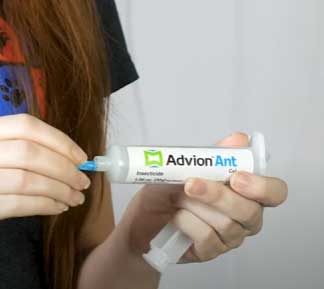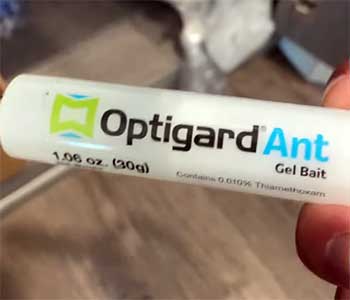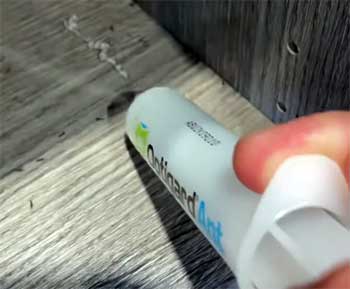As someone who’s battled ant invasions in my kitchen, I know the frustration of watching those tiny pests march in like they own the place.
I’ve tried everything from home remedies to store-bought traps, but two products consistently stand out: Advion and Optigard ant baits. In this article, I’ll share my firsthand experience comparing these two powerhouse ant gels, breaking down their pros, cons, and key features to help you decide which one suits your needs.
Whether you’re facing a minor ant problem or a full-blown infestation, I’ve got you covered with practical insights to reclaim your space.
A Brief Comparison Table
| Feature | Advion Ant Gel | Optigard Ant Gel |
| Active Ingredient | Indoxacarb (0.05%) | Thiamethoxam (0.01%) |
| Target Ant Species | Argentine, carpenter, fire, odorous house, etc. | Argentine, carpenter, ghost, odorous house, etc. |
| Application Method | Gel in syringe, bait stations | Gel in syringe, bait stations |
| Speed of Action | 24-48 hours for noticeable reduction | 24-72 hours for noticeable reduction |
| Residual Effect | Up to 3 months | Up to 3 months |
| Ease of Use | Easy-to-apply syringe | Easy-to-apply syringe |
| Pet/Child Safety | Safe when used as directed | Safe when used as directed |
| Odor | Low odor | Odorless |
| Indoor/Outdoor Use | Both | Both |
| Price (Approx. for 30g) | $30-$40 | $35-$45 |
My Journey With Ant Baits: Why This Comparison Matters?
Let me set the scene: it’s a warm summer evening, and I’m enjoying a quiet moment at home when I spot a trail of ants marching across my countertop. Not just a few stragglers—hundreds of them, zeroing in on a forgotten crumb.
I’ve been here before, and I know spraying them with a random chemical won’t cut it. Ants are relentless, and I needed something that would not only kill the ones I could see but also wipe out the colony hiding in the walls.
That’s when I turned to Advion and Optigard, two ant baits that promised to get the job done. But which one is better? Let’s break it down.
Understanding Ant Baits: How They Work?

Before we get into the specifics of Advion and Optigard, let’s talk about how ant baits work.
Unlike sprays that kill on contact, baits are designed to be a Trojan horse.
Worker ants pick up the bait, carry it back to their colony, and share it with their buddies, including the queen.
Once the queen is out of commission, the colony collapses.
Both Advion and Optigard use this strategy, but their active ingredients and formulations make a difference in how they perform. Knowing this helped me understand why some baits worked better than others in my home.
Advion Ant Gel: My Experience And Key Features
Advion Ant Gel, made by Syngenta, is a heavyweight in the pest control world. Its active ingredient, indoxacarb, is a slow-acting poison that gives ants time to share the bait before they kick the bucket. Here’s what I found when I used it:
Pros of Advion
- Broad-Spectrum Effectiveness: Advion targets a wide range of ant species, including Argentine, carpenter, fire, and odorous house ants. In my home, I was dealing with Argentine ants, and Advion took them out like a champ.
- Fast Results: Within 24 hours, I noticed fewer ants on my countertops. By day three, the trails were gone. The speed was impressive, especially compared to homemade solutions like vinegar.
- Easy Application: The syringe makes it simple to apply small dabs of gel where ants are active. I placed some near entry points and along trails, and the ants couldn’t resist.
- Long-Lasting: The residual effect lasts up to three months, which meant I didn’t have to reapply often. This was a lifesaver during peak ant season.
- Low Odor: The gel has a faint chemical smell, but it’s barely noticeable. I didn’t have to air out my kitchen after using it.
Cons of Advion
- Pricey: At $30-$40 for a 30-gram tube, it’s not the cheapest option. I winced at the cost initially, but the results justified it.
- Messy if Overapplied: If you squeeze out too much gel, it can get sticky and attract dust. I learned to use tiny dots after a few trial-and-error messes.
- Not Ideal for All Surfaces: The gel can leave a residue on porous surfaces like wood. I had to be careful where I applied it in my older home.
My Take On Advion
Advion became my go-to when I needed quick results. The first time I used it, I was skeptical—how could a tiny dab of gel stop an army of ants?
But watching those pests swarm the bait and then disappear within days was oddly satisfying. It’s like sending them on a mission they won’t return from.
The syringe applicator was a game-changer, letting me target hard-to-reach spots like cracks near my sink. However, I had to be strategic about placement to avoid any sticky cleanup.
Optigard Ant Gel: My Experience And Key Features
Optigard, also from Syngenta, uses thiamethoxam as its active ingredient. It’s another slow-acting bait designed to take down entire colonies. Here’s what I discovered when I gave it a try:
Pros of Optigard

- Wide Ant Coverage: Like Advion, Optigard works on multiple ant species, including Argentine, ghost, and carpenter ants. It handled my Argentine ant problem just as well as Advion did.
- Odorless: Unlike Advion’s slight odor, Optigard is completely odorless, which I appreciated in my small apartment where smells linger.
- Flexible Application: The syringe applicator is user-friendly, and the gel’s clear appearance blends in better than Advion’s slightly opaque formula. I could place it discreetly on countertops.
- Pet and Child Safe: When used as directed, it’s safe around pets and kids. I felt confident using it in my home with a curious cat.
- Effective Residual Action: The bait remains active for up to three months, providing long-term protection. I didn’t see ants return for weeks after application.
Cons of Optigard
- Slightly Slower: While Advion showed results in 24-48 hours, Optigard took closer to 72 hours for a noticeable drop in ant activity. It wasn’t a dealbreaker, but I had to be patient.
- Higher Price Point: At $35-$45 for a 30-gram tube, it’s a bit more expensive than Advion. For budget-conscious folks, this could sting.
- Less Attractive to Some Ants: In one instance, I noticed a few ants ignoring the bait. It worked eventually, but it wasn’t as universally irresistible as Advion.
My Take On Optigard
Optigard felt like the more polished cousin of Advion. Its odorless formula and clear gel made it feel less intrusive in my home. I used it in my bathroom, where ants were sneaking in through a window, and the syringe let me apply it precisely along the sill.
The results were solid, but I had to wait an extra day or two compared to Advion. If you’re sensitive to smells or want a discreet option, Optigard’s a strong contender.
Head-to-Head Comparison of Advion And Optigard

Now that I’ve used both products, let’s compare them across key factors to help you decide which one fits your situation.
- Active Ingredients: Indoxacarb vs. Thiamethoxam
Advion’s indoxacarb is a unique pesticide that requires metabolic activation inside the ant’s body, making it highly effective at low doses (0.05%). It’s like a stealth weapon—ants don’t realize they’re poisoned until it’s too late.
Optigard’s thiamethoxam (0.01%) is a neonicotinoid, which disrupts the ant’s nervous system. Both are deadly to ants, but indoxacarb’s slightly higher concentration seemed to give Advion a slight edge in speed during my tests.
- Speed of Action
Advion was the faster of the two in my experience. I saw a significant reduction in ant activity within 24-48 hours, while Optigard took 48-72 hours. If you’re dealing with a heavy infestation and want quick relief, Advion might be your pick.
But Optigard’s slower action didn’t mean it was less effective—just that it required a bit more patience.
- Ease of Use
Both products come in syringe applicators, which I found intuitive and precise. Advion’s gel is slightly thicker, which made it easier to control but stickier if overapplied. Optigard’s thinner, clearer gel was easier to clean up but sometimes spread more than I intended.
It’s a toss-up here—both are user-friendly, but your preference might depend on how much you care about cleanup.
- Safety and Odor
Both baits are safe for pets and kids when used as directed, but I was extra cautious by placing them in areas my cat couldn’t reach, like behind appliances.
Advion’s low odor was fine, but Optigard’s complete lack of smell was a big plus in my small space. If you’re sensitive to chemical odors, Optigard might be the better choice.
- Price and Value
Advion is generally $5-$10 cheaper than Optigard for a 30-gram tube. While both are effective, Advion’s lower price and faster action gave it a slight edge for me.
However, if you value an odorless, discreet application, Optigard’s higher cost might be worth it.
- Effectiveness Across Ant Species
Both products target similar ant species, but I found Advion slightly more attractive to the Argentine ants in my home.
Optigard worked well, but in one case, a small group of ants seemed less interested in it. If you’re dealing with picky ants like ghost ants, Advion’s broader appeal might give it an advantage.
Real-World Scenarios: Which One Should You Choose?
Let’s get practical. Here are some scenarios based on my experience to help you pick the right bait:

- Heavy Infestation in a Hurry: If your kitchen looks like an ant highway, go with Advion. Its faster action (24-48 hours) will give you quicker relief.
- Small Space or Odor Sensitivity: If you live in a small apartment or hate chemical smells, Optigard’s odorless formula is a better fit.
- Budget-Conscious Buyer: Advion’s lower price point makes it a solid choice if you’re watching your wallet but still want reliable results.
- Discreet Application: Optigard’s clear gel blends in better on visible surfaces, making it ideal for places like countertops or bathrooms.
- Picky Ants: If you’re dealing with ants that ignore other baits, Advion’s indoxacarb seems to have a slight edge in attracting a wider range of species.
Tips for Using Ant Baits Effectively
No matter which bait you choose, how you use it matters. Here are some tips I learned the hard way:
- Apply Small Amounts: A pea-sized dab is enough. Overapplying wastes product and makes a mess.
- Target Ant Trails: Place the gel where you see ants marching. They’ll take it back to the colony.
- Clean First: Remove competing food sources like crumbs or spills so ants focus on the bait.
- Be Patient: It takes time for the bait to reach the queen. Don’t panic if you see more ants initially—they’re just excited about the bait.
- Store Properly: Keep unused bait in a cool, dry place to maintain its potency.
My Verdict: Advion Or Optigard?
After testing both, I lean toward Advion for its speed and slightly better attractiveness to ants in my home. It’s also a bit more budget-friendly, which doesn’t hurt.
But Optigard’s odorless, clear formula makes it a close second, especially if you prioritize discretion or have a sensitive nose. Both are top-tier products, and you can’t go wrong with either—it really comes down to your specific needs.
FAQ: Quick Answers To Common Questions
Optigard is more effective for a wider range of ant species and has a longer residual effect than Terro, which uses borax and is better for sweet-loving ants.
Yes, Optigard works well against many ant species, typically reducing activity within 48-72 hours by targeting the colony.
Optigard’s active ingredient is thiamethoxam (0.01%), a neonicotinoid that disrupts ants’ nervous systems.
Optigard starts reducing ant activity within 48-72 hours, with full colony elimination often taking a week.
Conclusion: Your Path To An Ant-Free Home
You’ve got ants, and you want them gone—I’ve been there. Advion and Optigard are both powerful tools to help you win this battle, each with its own strengths. Advion’s speed and affordability make it my personal favorite, but Optigard’s odorless, discreet formula is perfect for certain situations.
Use the comparison table and my insights to pick the one that fits your home and lifestyle. Whichever you choose, you’re one step closer to reclaiming your space from those pesky invaders.
Got a specific ant problem? Let me know, and I’ll help you figure out the next move!
